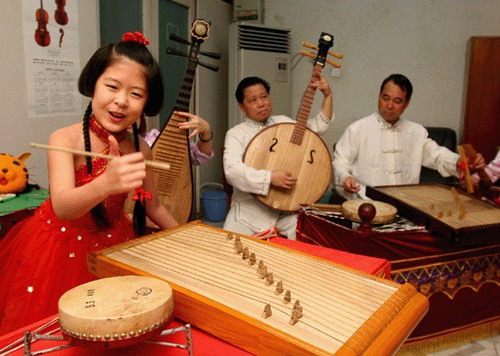Wenzhou Guci (Wenzhou Drumbeat Lyrics) is a distinctive folk singing tune popular in Wenzhou of Zhejiang Province and the adjacent areas. It is also called "Changci" (singing lyrics). As most of the actors engaged in this art in the past were blind men, it is also called "瞽词" (guci) or "盲词" (mangci) [both "瞽" and "盲" mean blind].

The uncle of Emperor Minghuang of Tang was said to be the founder of Wenzhou Guci. He was intelligent from childhood, and when he grew up he was good at writing poems and proficient in music, but unfortunately he suffered blindness later. Then he invented Guci and taught it to other blind men to amuse themselves. In terms of literary form, Wenzhou Guci comes down in one continuous line with the bianwen (a form of narrative literature) of the Tang Dynasty, as "Dunhuang Bianwen is the forerunner of all the talking and singing literature". One saying has it that Wenhzou Guci basically took shape in the Southern Song Dynasty, but another version regards that it basically took shape in the Ming Dynasty by combining Qu (a kind of folk tune) with Ciqu (another kind of folk tune) in alleyways of Hengyang.

From the prospective of singing mode, Wenzhou Guci can be classified into two kinds: "Pingci" and "Daci". The former is usually performed in the weddings, funerals or the reception parties, while the latter is also named "Niangniangci". When sing the "Daci", one drum is one time value, and the big drums and big gongs are played, which produce a sonorous, rough and aboriginal tune. The 14th Madam Chen is the major program of Wenzhou Guci, and this long story about the madam killing demons can be sung for several days and nights.
Wenzhou Guci contains singing and talking, and singing plays a major part. The singing and tune of Wenzhou Guci is of distinctive folk song flavor of South China. The basic tunes include slow beat, flowing beat and rapid beat and other scores of kinds of beats. As Wenzhou Guci is sung with Wenzhou dialect (taking Rui'an dialect as a standard) and there are different accents in this language, so the singings differ from each other and each one has its own features. Generally speaking, Wenzhou Guci can be divided to South School and North School. The South School features delicacy and softness, while the North School features roughness and primitive simplicity. Wenzhou Guci is usually sung to express the emotions and tell stories, and it often uses the oral language to make it easily understood. A lot of idioms from the commons and proverbs of the folks are also used in it. The play of Wenzhou Guci can be divided to "Zheshuer", "Xiaoshuo" and "Bushu". Most of the lines have seven characters, but there are also five-character lines and dieban (repeated beats). In Wenzhou Guci, the verse and narration alternate with each other, and most of its subject matters derive from folk tales and historical novels that represent the vicissitudes of life and love stories. The moral and ethics, aesthetic interest and value of human life in Wenzhou Guci are identical with the spirit of traditional Chinese culture.

The main musical instruments used in Wenzhou Guci are flat drum, sanliban, Niujinqin (beef tendon fiddle) and Xiaobaoyue. The most important characteristic is that in the performance one actor can play four to six instruments. And one actor plays different roles (nowadays the male and female antiphonal singing is adopted sometimes), and the clear articulation and precise portrayal of figures are also the requirement of Wenzhou Guci. The plots must be narrated in detail, and the idiosyncrasy and manner of the figures must be accurately expressed. One actor can play many different figures and simulate different sounds to enhance the atmosphere.